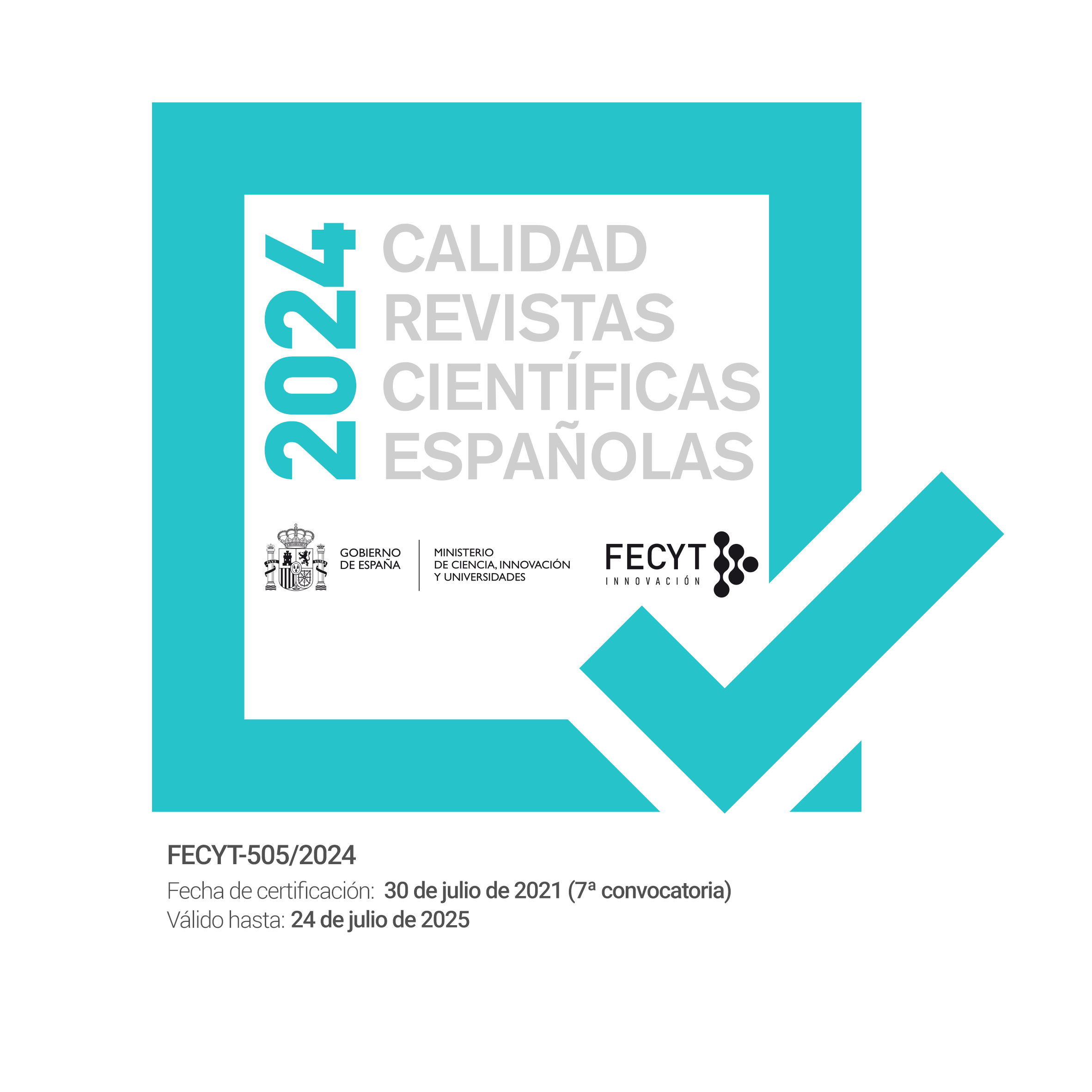Entre el malson i la realitat. Reflexions distòpiques sobre la societat contemporània
DOI:
https://doi.org/10.7203/qfia.7.2.18804 Abstract
Abstract
Between Nightmare and Reality: Dystopian Reflections on the Contemporary Society
Resum: Per mitjà de la narració de fantasia i de ciència ficció, la utopia i la distopia promouen una anàlisi crítica de la realitat. En particular, la distopia ens alerta de les possibles conseqüències catastròfiques derivades de problemes sociopolítics existents i contribueix a la reflexió constructiva sobre les amenaces antidemocràtiques que posen en perill la nostra societat. Aquest article examina la representació de l’autoritat, la coacció, la propaganda, la plasmació, l’espai i el llenguatge en distopies sociopolítiques seleccionades i reconegudes, com Nosaltres de Zamiatin, Un món feliç de Huxley, La nit de l’esvàstica de Burdekin, 1984 d’Orwell i El conte de la serventa de Atwood, i compara aquestes ficcions amb esdeveniments històrics i contemporanis, amb l'esperança d’il·luminar la manera real en què el poder opera sobre els cossos i les ments en sistemes tant repressius com liberals.
Abstract: Through fantasy and science fiction storytelling, utopia and dystopia promote a critical analysis of reality. In particular, dystopia warns against the possible nightmarish consequences of factual socio-political issues, as well as it fosters a constructive and thought-provoking reflection on the undemocratic threats that jeopardize our society. This article examines the representation of authority, coercion, propaganda, embodiment, space, and language in selected and renowned socio-political dystopias, including Zamyatin’s We, Huxley’s Brave New World, Burdekin’s Swastika Night, Orwell’s 1984, and Atwood’s The Handmaid’s Tale, and it subsequently compares these fictional depictions with historical and contemporary events, hoping to shed light on the real way that power operates on bodies and minds both in repressive and liberal systems.
Paraules clau: distopia, utopia, control, violència, realització
Keywords: Dystopia, Utopia, Control, Violence, Embodiment
 Downloads
Downloads
 References
References
ARCIERO, A. 2005, Orwell: contro il totalitarismo e per un socialismo democratico, Milano: Franco Angeli.
ARENDT, H. 1962, The Origins of Totalitarianism, Cleveland: Meridian Books.
ATWOOD, M. 2007, Il Racconto dell'Ancella, Milano: Tea.
AUSTIN, J.L. 1975, How to Do Things with Words, Cambridge: Harvard University Press.
BACCOLINI, R., MOYLAN, T. (eds.) 2003, Dark Horizons. Science Fiction and the Dystopian Imagination, New York-London: Routledge.
BATTAGLIA, B. 1998, Nostalgia e mito nella distopia inglese, Ravenna: Longo.
BERNAYS, E. 1947, “The Engineering of Consent”, The Annals of the American Academy of Political and Social Science, 270 (1): 113-120.
BOOKER, M.K. 1994, Dystopian Literature. A Theory and Research Guide, Westport: Greenwood Press.
BOYE, K. 1993, Kallocaina, Milano: Iperborea.
BURDEKIN, K. 1985, Swastika Night. New York: Feminist Press.
CÉSAIRE, A. 1999, Discorso sul Colonialismo, Roma: Lilith.
CHIAIS, M. (2008), Menzogna e propaganda: armi di disinformazione di massa, Milano: Lupetti.
CHOMSKY, N. 2011, Media Control. The Spectacular Achievements of Propaganda, New York: Seven Stories Press.
COLOMBO, A. 1987, Utopia e Distopia, Milano: Franco Angeli.
COURTOIS, S. 1998, Il Libro Nero del Comunismo, Milano: Mondadori.
DALCHER, C. 2018, Vox, Milano: Nord.
DE BEAUVOIR, S. 2010, The Second Sex, New York: Vintage Books.
DI MINICO, E. 2018, Il futuro in bilico, Milano: Meltemi.
ELICHAOFF, F., FROST, N. 2014, “Feminist Postmodernism, Poststructuralism, and Critical Theory”, en Feminist Research Practice: A Primer, ed. Hesse-Biber, S., Thousands Oaks: SAGE Publications.
FERNÁNDEZ BUEY, F. 2007, Utopías e ilusiones naturales, Barcelona: El Viejo Topo.
FIMIANI, E. 2004, “I linguaggi politici del Fascismo ai tempi dei plebisciti”, en Propaganda e comunicazione politica, ed. Ridolfi, M., Milano: Mondadori.
FORSTER, E. M. 2020, La macchina si ferma, Milano: Mondadori.
FOUCAULT, M. 2004, La Volontà di Sapere. Storia della Sessualità 1, Milano:Feltrinelli.
FOUCAULT, M. 1993, Sorvegliare e punire, Torino: Einaudi.
GENTILE, E. 2007, Le religioni della politica. Fra democrazie e totalitarismi, Bari: Laterza.
GOLDBLATT, P. 1999, “Reconstructing Margaret Atwood's Protagonists”, World Literature Today, 73 (2): 275-282.
HIGDON, N. 2020, The Anatomy of Fake News, Berkeley: University of California Press.
HUXLEY, A. 2009, Mondo Nuovo. Ritorno a Mondo Nuovo, Milano: Mondadori.
INDERBITZIN, M.L., et al. 2012, Deviance and Social Control. A Sociological Perspective, London: Sage Publication.
IPSOS 2019, “Ciak Migraction: Indagine sulla percezione dei migranti in Italia”, 19 Ottobre, https://www.ipsos.com/it-it/ciak-migraction-indagine-sulla-percezione-del-fenomeno-migratorio-italia
KNIGHT, D. 2011, Hell’s Pavement, London: Hachette UK.
KUMAR, K. 1991, Utopia and Anti-Utopia in Modern Times, Oxford: Blackwell.
LE BON, G. 2001, The Crowd. A Study of the Popular Mind, Kitchener: Batoche Books, (ebook).
LIPPMANN, W. 1998, Public Opinion, New Brunswick: Transaction Publishers.
LOMBARD, N., MCMILLAN, L. 2013, Violence Against Women. Current Theory and Practice in Domestic Abuse, Sexual Violence, and Exploitation, London: Jessica Kingsley Publishers.
MALTONE, C. 2011, “L’immigrazione nei media italiani. Disinformazione, stereotipi e innovazioni”, Line@editorialen.3.
MANFERLOTTI, S. 1984, Antiutopia: Huxley, Orwell, Burgess, Palermo: Sellerio.
MARCUSE, H. 1993, El hombre unidimensional, Barcelona: Planeta De Agostini.
MCKAY, G. 1996, “Katharine Burdekin: An Alien Presence in Her Own Time”, en Recharting the Thirties, ed. Quinn, P.J., London: Associated University Presses.
MCLUHAN, M. 2002, Gli strumenti del comunicare, Milano: NET, Milano.
MCLUHAN, M. 1969, El medio es el masaje, Buenos Aires: Editorial Paidos.
MOORE, A., LLOYD, D. 2006, V per Vendetta, Roma: Magic Press.
MOSSE, G. 2007, Le Guerre Mondiali. Dalla tragedia al Mito dei Caduti, Roma: Laterza.
MOSSE, G. 2007, La Nazionalizzazione delle Masse, Bologna: Il Mulino.
OMS 2017, “Violencia contra la mujer”, November 29, https://www.who.int/es/news-room/fact-sheets/detail/violence-against-women
ORWELL, G. 2020, 1984, Madrid: Verbum.
OSCE 2019, “Hate Crime Reporting. 2018 Hate Crime Data”, November 19, https://hatecrime.osce.org/infocus/2018-hate-crime-data-now-available
PACKARD, V. 2007, The Hidden Persuaders, New York: IG Publishing.
PANATTONI, R. 2002, Storia del romanzo, Milano: Alpha Test.
POHL, F., KORNBLUTH, C.M. 2008, Mercaderes del espacio, Barcelona: Ediciones Minotauro.
POSTMAN, N. 2005, Amusing Ourselves to Death, New York: Penguin Books.
REICH, W. 1977, La psicologia di massa del Fascismo, Milano: Mondadori (ebook).
REID-CUNNINGHAM, A. 2008, “Rape as a Weapon of Genocide”, Genocide Studies and Prevention 3 (3): 279-96.
RUSHIN, S., GRIFFIN, S.E. 2018, “The Effect of President Trump's Election on Hate Crimes”, SSRN Electronic Journal, January 14,https://papers.ssrn.com/sol3/papers.cfm?abstract_id=3102652
RUSSELL, E. 1991, “The loss of the feminine principle in Charlotte Haldane’s Man’s World and Katharine Burdekin’s Swastika Night”, en Where no man has gone before: Women and Science Fiction, ed. Armitt , L., London-New York: Routledge.
SARGENT, L.T. 1975, “Utopia: The Problem of Definition”, Extrapolation 16 (2): 137-48.
SCARRY, E. 1990, La sofferenza del corpo, Bologna: Il Mulino.
SCHMITT, C. 2007, The Concept of the Political, Chicago: University of Chicago Press.
SHAH, B. 2018, Before She Sleeps, Harrison: Delphinium Books.
UNODC 2019, Gender Studies on Homicide. Gender-related Killing of Women and Girls, Vienna: Division for Policy Analysis and Public Affairs - United Nations Office on Drugs and Crime.
VOLKOFF, V. 2006, Le montage, Paris: Pocket.
ZAMIATIN, Y. 2007, Noi, Milano: Lupetti.
ZIMBARDO, P. 2011, The Lucifer Effect. How Good People Turn Evil, New York: Random House.
ZUMAS, L. 2018, Relojes de sangre, Barcelona: Ediciones Destino.
PEL·LÍCULES I SÈRIES
AGUILERA, P. 2016-2020, 3%, Netflix.
ANDERSON, M. 1976, La fuga de Logan, Metro-Goldwyn-Mayer.
BLOMKAMP, N. 2013, Elysium, Warner Bros.
BONG, J. 2013, Snowpiercer, The Weinstein Company.
CARPENTER, J. 1988, Están vivos, Universal Pictures.
FUKUNAGA, C. 2018, Maniac, Netflix.
LUCAS, G. 1971, THX 1138, Warner Bros.
Downloads
Published
How to Cite
-
Abstract443
-
PDF (Català)362
Issue
Section
License
![]()
Works published in QUADERNS DE FILOSOFIA are under the licence Creative Commons Attribution-NonComercial-NoDerivatives 4.0 International.
Authors retain copyright and grant the journal right of first publication with the work simultaneously licensed under a Creative Commons Attribution License that allows others to share the work with an acknowledgement of the work's authorship and initial publication in this journal.
Authors are able to enter into separate, additional contractual arrangements for the non-exclusive distribution of the journal's published version of the work (e.g., post it to an institutional repository or publish it in a book), with an acknowledgement of its initial publication in this journal.
The authors authorize the publisher to archive the article into databases and indexes (such as EBSCO, DOAJ, ProQuest), and permit the publisher to apply DOI to the article.
Authors are permitted and encouraged to post their work online (e.g., in institutional repositories or on their website) prior to and during the submission process, as it can lead to productive exchanges, as well as earlier and greater citation of published work (See The Effect of Open Access).





